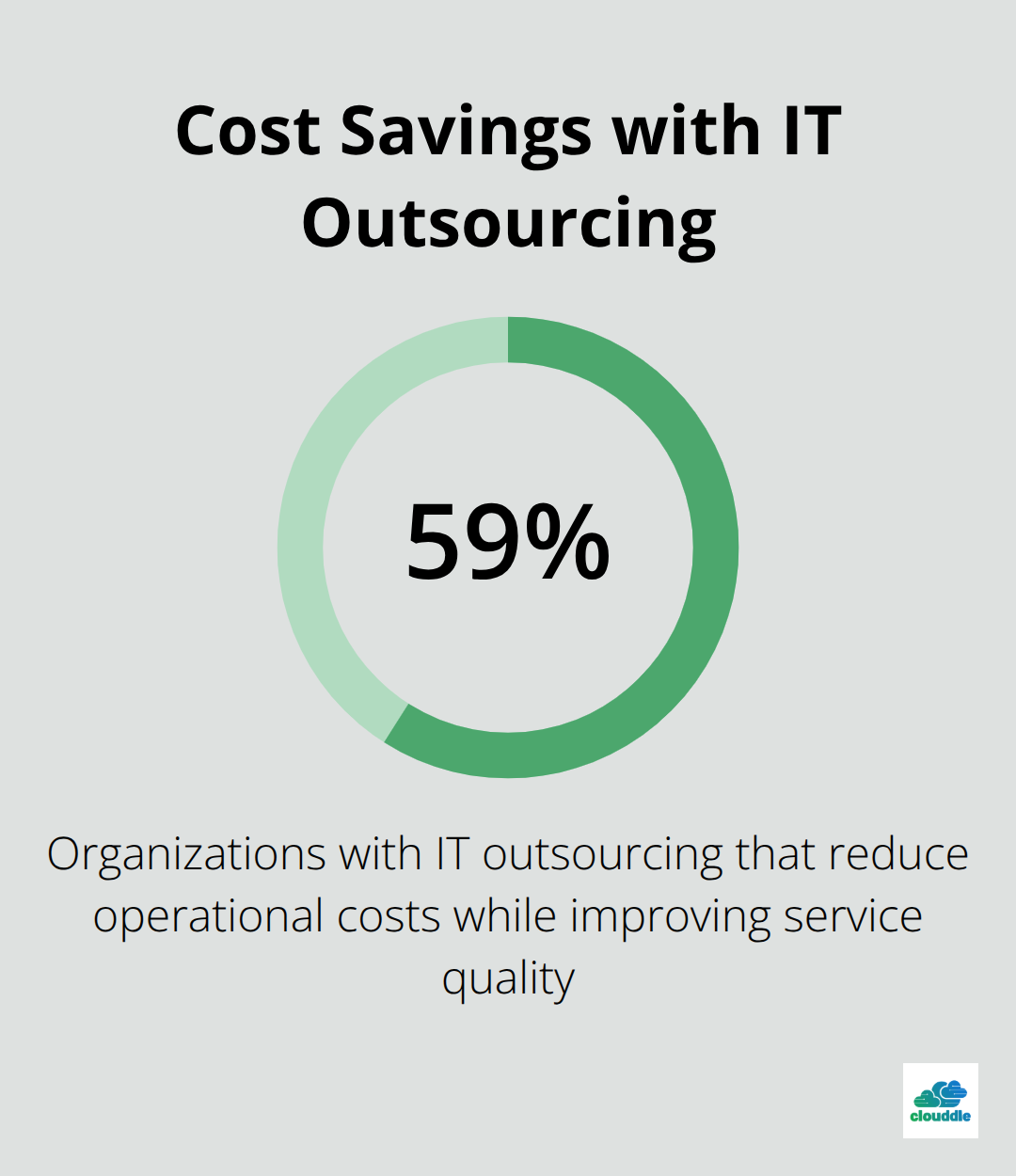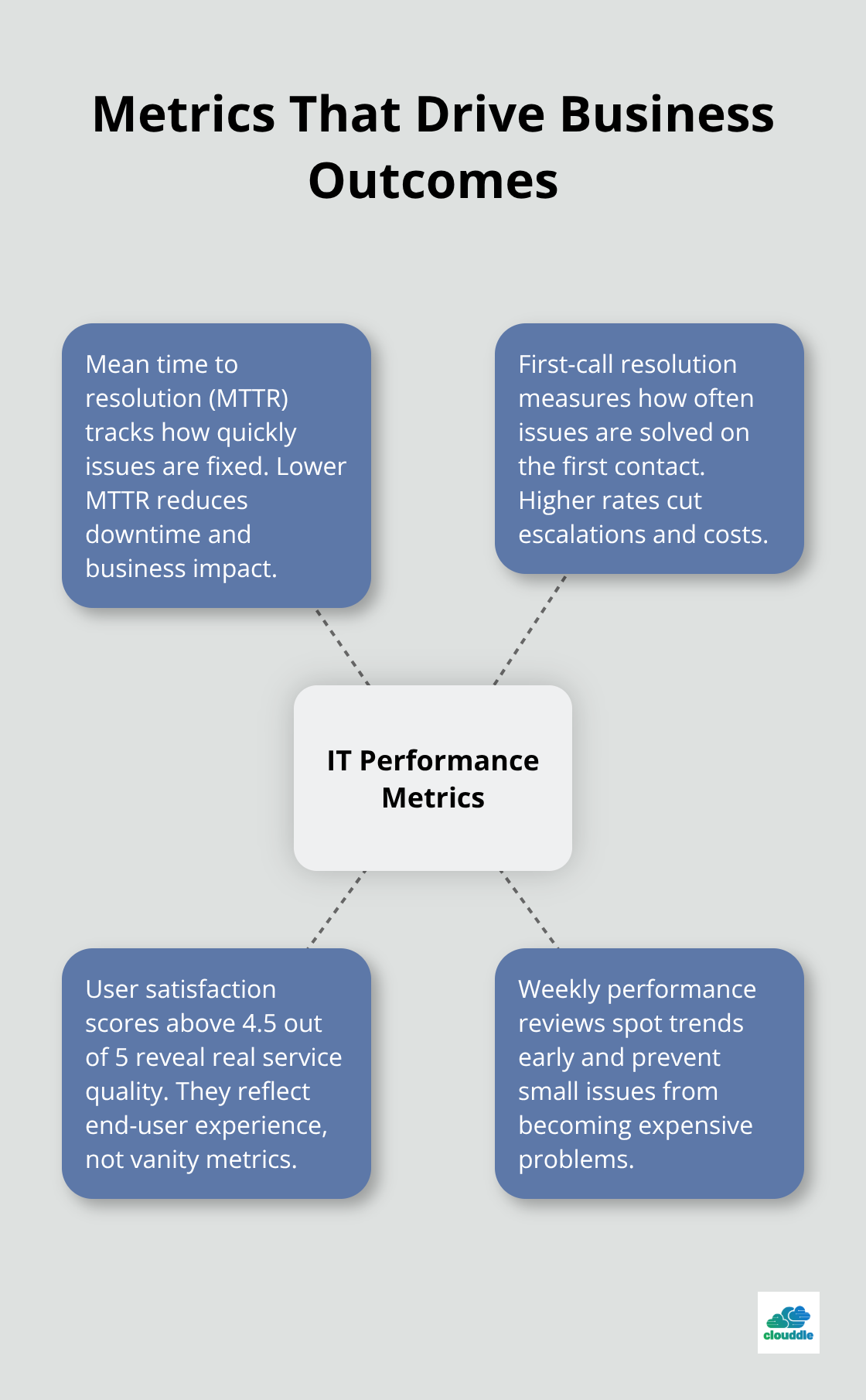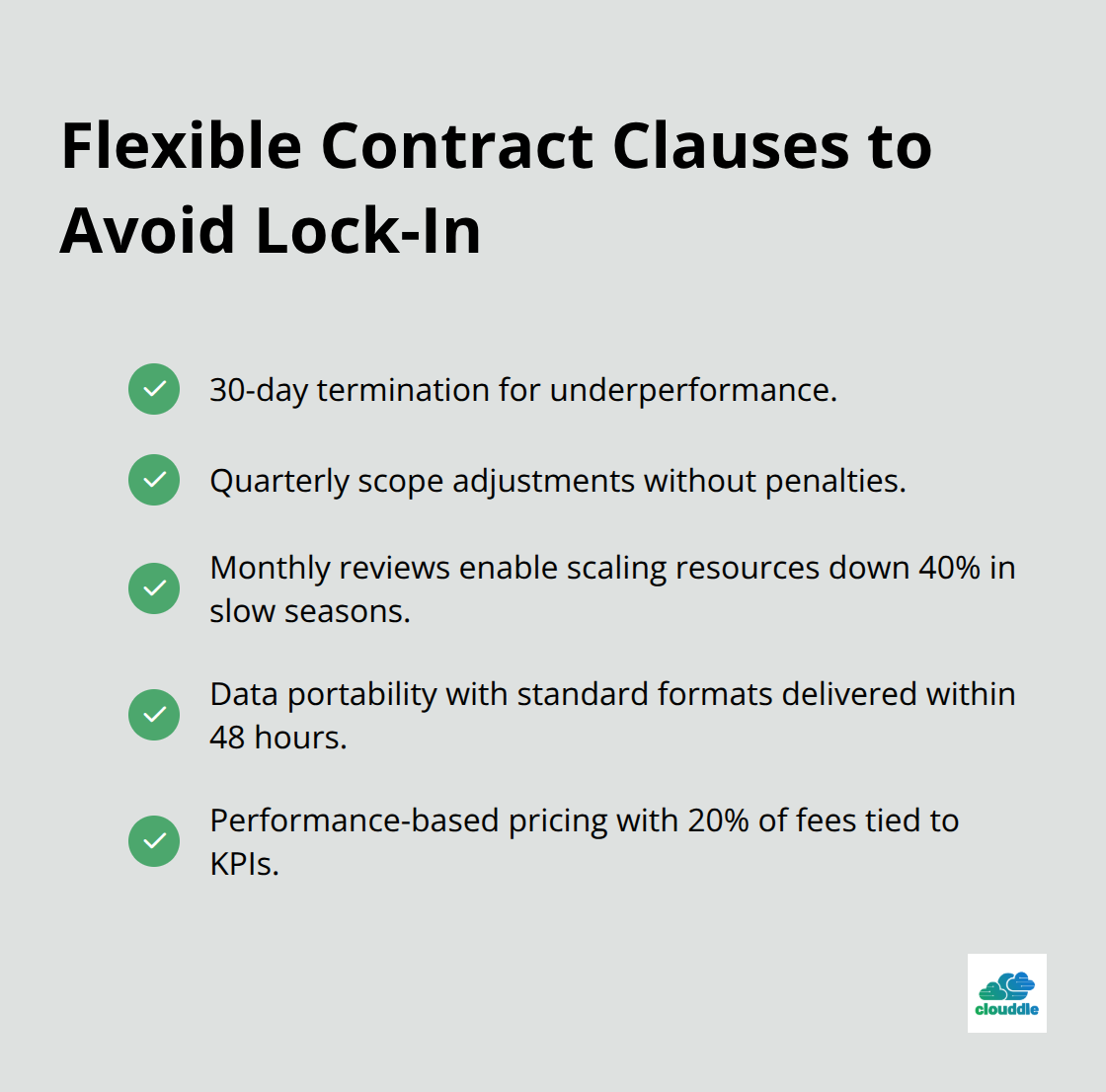IT outsourcing has become a strategic necessity for businesses seeking competitive advantages. Companies that master how to maximize flexibility and control through outsourcing partnerships see 23% faster growth rates than their competitors.
At Clouddle, we’ve observed that successful outsourcing requires balancing operational freedom with strategic oversight. The key lies in implementing proven frameworks that protect your business interests while accessing specialized expertise.
Why IT Outsourcing Transforms Business Operations
Access to Elite Technical Expertise
The skills gap in IT has reached critical levels, with 60% of companies citing the scarcity of tech talent and skills as a key inhibitor of transformation. McKinsey research shows that companies with strategic outsourcing outperform competitors by 15-20% in project delivery efficiency. This performance gap exists because outsourcing partners employ specialists who focus exclusively on specific technologies. A financial services firm that partnered with an external DevOps team reduced deployment times from weeks to hours, while their internal team concentrated on customer-facing innovations.
Instant Resource Scaling Without Overhead
Traditional processes for technical hires take 3-6 months and cost $15,000 per position according to recent industry data. Outsourcing eliminates this timeline entirely. When a retail company needed to scale their e-commerce platform for Black Friday, their outsourcing partner provided 12 additional developers within 48 hours. The same expansion would have required 8 months through internal processes. This agility becomes even more valuable during economic uncertainty when businesses need to adjust team sizes rapidly without layoff complications or long-term commitments.
Infrastructure Cost Elimination
Deloitte found that 59% of organizations with IT outsourcing reduce operational costs while they improve service quality. The math is straightforward: an internal IT department costs $120,000 annually per employee (including salaries, benefits, training, and equipment).

Strategic outsourcing converts these fixed costs into variable expenses that scale with actual usage. A manufacturing company eliminated $2.4 million in annual IT infrastructure costs while it gained access to enterprise-grade security tools that would have cost $500,000 to implement internally.
These operational advantages create the foundation for strategic control, but success depends on how you structure your outsourcing relationships from the start.
How Do You Control Outsourced IT Projects
Successful outsourcing control starts with quantifiable Service Level Agreements that define specific performance standards. The best SLAs include response times under 2 hours for critical issues, 99.9% uptime guarantees, and monthly performance reports with detailed metrics. A logistics company reduced project delays by 40% after it implemented SLAs that penalized their provider $500 per hour for missed deadlines. Smart businesses also establish key performance indicators that align with business outcomes rather than technical metrics alone. Revenue-impacting applications require different SLA terms than back-office systems.
Performance Metrics That Actually Matter
Track metrics that connect directly to business results rather than vanity numbers. Effective organizations monitor mean time to resolution, first-call resolution rates, and user satisfaction scores above 4.5 out of 5. A healthcare provider discovered their outsourced partner had 95% server uptime but 60% application availability during peak hours.

This mismatch cost them $50,000 in lost productivity monthly. Weekly performance reviews prevent small issues from becoming expensive problems.
Communication Frameworks for Oversight
Establish mandatory weekly status calls with project managers and monthly executive reviews with senior leadership from both teams. Successful partnerships require documented escalation procedures that activate within 24 hours for critical issues. Use project management platforms like Jira or Monday.com to track progress in real-time rather than wait for scheduled reports. A manufacturing firm maintained complete project visibility after it required their partner to update task statuses daily and provide automated alerts for any delays that exceeded 48 hours. Understanding the importance of IT project management helps establish these frameworks effectively.
Strategic Function Control
Never outsource core business logic or customer-facing applications without you maintain internal oversight capabilities. Keep strategic decision-making, data governance, and security policy management internal while you delegate implementation tasks. Companies that outsource everything lose the ability to evaluate vendor performance effectively. Retain at least one internal technical expert who can validate outsourced work quality and identify potential issues before they impact operations. Outsourced IT for small businesses requires careful balance between delegation and control.
The foundation of control lies in partner selection (which determines long-term success), but the right partnership structure requires specific strategies that maximize both flexibility and oversight.
What Makes an IT Outsourcing Partnership Actually Work
Industry Experience Determines Success Rates
Partner selection requires laser focus on industry-specific experience rather than general technical capabilities. Companies that choose providers with direct experience in their sector benefit from reduced project risks and improved compliance outcomes. A healthcare organization that selected a provider with HIPAA compliance expertise avoided $200,000 in potential penalties, while their competitor faced regulatory issues after choosing a generic IT firm. Financial services firms need partners who understand PCI DSS requirements, while manufacturing companies require providers experienced with industrial IoT security protocols. The difference between industry-experienced and general providers shows up immediately in implementation timelines and compliance adherence.
Contract Flexibility Prevents Vendor Lock-in
Smart contracts include 30-day termination clauses for underperformance and quarterly scope adjustment options without penalty fees. Avoid providers who demand multi-year commitments with steep exit costs – this signals confidence problems in their service delivery. A retail company negotiated monthly contract reviews that allowed them to scale resources down 40% during slow seasons, which saved $180,000 annually.

Include data portability clauses that guarantee your information in standard formats within 48 hours of contract termination. Performance-based pricing models (where 20% of fees depend on meeting specific KPIs) create accountability that fixed-price contracts lack.
Collaborative Relationships Drive Results
Treat outsourcing partners as extensions of your team rather than external vendors through shared project planning sessions and joint problem-solving approaches. Companies with collaborative partnerships benefit from improved issue resolution and stronger working relationships. Establish monthly strategy sessions where both teams review upcoming projects and resource needs together. Share business context and goals so your partner can proactively suggest improvements rather than just execute tasks.
Communication Protocols That Work
Weekly status calls with project managers and monthly executive reviews with senior leadership from both teams create accountability structures that prevent issues from escalating. Use project management platforms like Jira or Monday.com to track progress in real-time rather than wait for scheduled reports. A logistics firm that included their outsourcing partner in quarterly business reviews identified cost-saving opportunities worth $150,000 that would have been missed in a traditional vendor relationship. Regular face-to-face meetings (even virtual ones) build trust that translates into better project outcomes and proactive support.
Final Thoughts
Companies that implement strategic frameworks for IT outsourcing maximize flexibility and control while achieving 23% faster growth rates than competitors who treat outsourcing as simple cost reduction. Organizations must establish clear SLAs with performance penalties, maintain weekly communication protocols, and retain oversight of critical functions. The balance between operational freedom and strategic control determines long-term success.
Smart businesses negotiate flexible contract terms with 30-day termination clauses while they build collaborative partnerships through shared planning sessions and joint problem-solving approaches. Industry-specific expertise matters more than general technical capabilities when you select partners. Implementation starts with quantifiable performance metrics that connect to business outcomes rather than technical vanity numbers (establish mandatory reporting structures and retain internal technical expertise to validate outsourced work quality).
Companies in hospitality, multi-family dwelling, and senior living sectors can leverage specialized managed IT solutions that combine networking, security, and support services with flexible contracts and 24/7 customer support. Success in outsourcing comes from treating partners as team extensions while you maintain strategic decision-making authority internally. Organizations that master this balance transform IT outsourcing from a cost center into a competitive advantage that drives sustainable growth.


